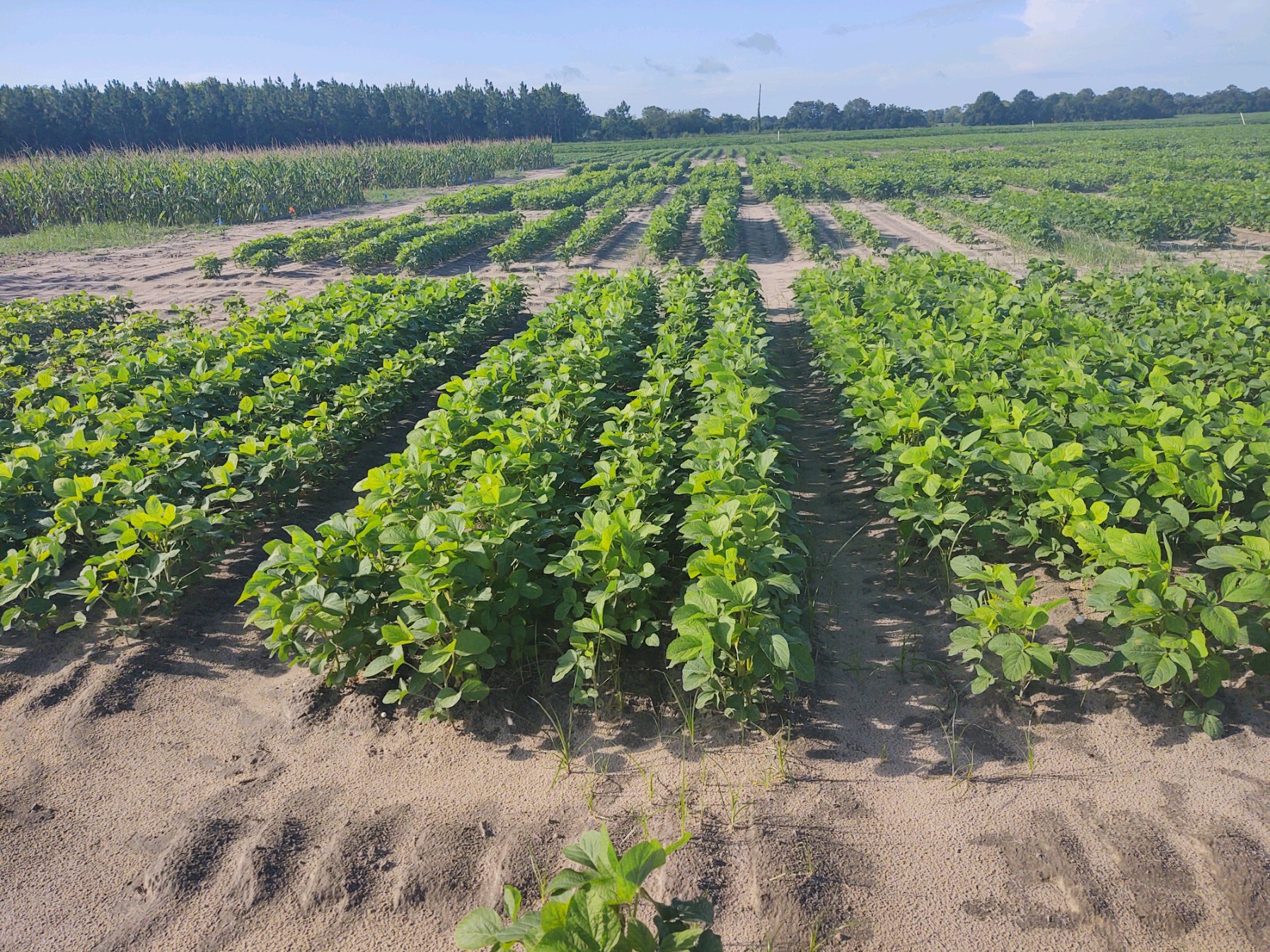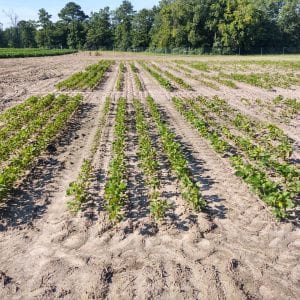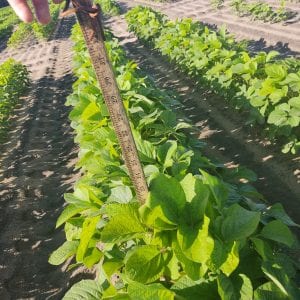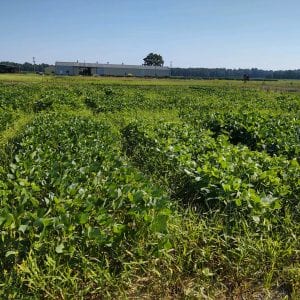Farming

Soybeans were a once popular forage choice in the 1800s and were grown as a forage in Alabama as recently as the 1930s. The use of soybeans shifted to oilseed production around World War II in an effort to increase the nation’s food supply during the war. Until recently, the primary efforts in soybean breeding focused on increasing oilseed yields. Now, soybeans have become a popular edition to food plots, which has resulted in improved forage-type cultivars being released. The following information highlights the results of a two-year small plot study evaluating forage and grain-type soybeans grown at two row spacings and harvested at three stubble heights. This study was conducted in Shorter and Headland, Alabama during 2019 and 2020.
Grain-Type vs. Forage-Type Cultivars
Breeding is the main difference between grain and forage-type cultivars. Grain-type soybean cultivars have been selectively bred to produce greater oilseed yields, whereas forage-type soybean cultivars have been selectively bred for greater leaf and stem biomass.
The following cultivars were evaluated in the study:
- ‘Stonewall’ (forage-type)
- ‘Tower of Leaves’ (Forage-type)
- ‘Laredo’ (Forage-type)
- ‘AG64X8’ (Grain-type)
- ‘AG79X9’ (Grain-type)
The following data was measured:
- Forage yield
- Digestible energy
- Crude protein
- Neutral detergent fiber
- Acid detergent fiber
- Total digestible nutrients
- In vitro dry matter digestibility
Seeds were planted using a grain drill at a rate of 210,000 seeds per acre from mid May to mid June. Plots were planted in 14 and 28 inch rows and were fertilized according to soil test results. Insecticides and herbicides were applied on an as-needed basis. Soybeans were harvested to 4, 6, and 8 inches stubble heights from late July to mid-August. If regrowth allowed, plots were harvested a second time in early September. Forage mass was summed across harvests, while nutritive value responses were averaged across harvests.
Conclusions
Location. Soybeans produced higher forage yields but lower nutritive value at the Headland study plot compared to the Shorter plot. This is likely a result of quicker growth at the more southern location, resulting in more mature forage.
Row Spacing. There were no differences recorded between row spacings for forage yield or nutritive value. Previous research has suggested that forage yield is greater in wider row spacings because individual plants can grow larger. However, in this study, a wider row spacing did not result in a greater forage yield.
Stubble Height. Decreases in stubble height from 8 to 4 inches resulted in increasing forage yield but decreased forage quality. This is likely because of a greater amount of stem material in relation to leaf material below the 8 inch height, resulting in increased fiber fractions. To optimize both forage yield and quality, the ideal height to harvest at is 6 inches. This gives an intermediate forage yield, with quality closer to that of the 8 inches cutting height.
Cultivar. The Stonewall cultivar produced the greatest yield, while also producing high nutritive value. While Stonewall produced lower CP than the other cultivars, the CP recorded in Stonewall was only 1.1 percent less than the cultivar with the highest CP. This makes Stonewall an ideal choice for a forage cultivar. Tower of Leaves was also high yielding, but resulted in lower nutritive value, while AG79X9 was higher in nutritive value, but had a lower yield. However, for maximum forage quality and yield, a forage-type soybean should be used.
Table 1. Forage Yield and Nutritive Value of Soybean Research Plots
Bolded numbers are not different from the greatest value within each column and parameter (i.e., Location, Row Spacing, Stubble Height, and Cultivar).
| Yield | Digestible Energy | Crude Protein | Neutral Detergent Fiber | Acid Detergent Fiber | Total Digestible Nutrients | In Vitro Dry Matter Digestibility | |
|---|---|---|---|---|---|---|---|
| Location | |||||||
| E.V. Smith | 1,242 | 1.07 | 18.4 | 46.8 | 36.8 | 53.2 | |
| Wiregrass | 1,904 | 0.97 | 14.0 | 46.2 | 38.5 | 48.5 | |
| Row Spacing | |||||||
| 14 in | 1,526 | 1.02 | 16.1 | 46.5 | 37.6 | 50.9 | |
| 28 in | 1,619 | 1.02 | 16.3 | 46.5 | 37.7 | 50.8 | |
| Stubble Height | |||||||
| 4 in | 1,830 | 0.98 | 15.1 | 47.5 | 39.9 | 49.0 | 66.1 |
| 6 in | 1,585 | 1.03 | 16.6 | 46.5 | 37.3 | 51.3 | 75.1 |
| 8 in | 1,304 | 1.05 | 16.9 | 45.5 | 36.6 | 52.3 | 77.1 |
| Cultivar | |||||||
| Stonewall | 1,830 | 1.03 | 15.8 | 45.5 | 36.8 | 51.3 | 72.5 |
| AG79X9 | 1,490 | 1.03 | 16.4 | 46.1 | 37.1 | 51.3 | 73.8 |
| AG64X8 | 1,579 | 1.03 | 16.9 | 46.6 | 37.8 | 51.3 | 74.3 |
| Tower of Leaves | 1,750 | 1.00 | 15.7 | 47.0 | 38.4 | 49.7 | 71.7 |
| Laredo | 1,196 | 1.02 | 16.3 | 47.3 | 38.1 | 50.7 | 71.6 |
Implications
Soybeans proved to be a high quality, warm-season annual legume option that can be useful for producers. Soybeans would be an ideal short-term forage to use in crop rotation systems, as well as a good choice to use to increase the quality of already established warm-season forage systems. They can also be used in mixtures with other warm-season annuals such as pearl millet, sorghum, sudangrass, and sorghum × sudangrass hybrids. Soybeans may also be a useful emergency forage. Grain soybeans were similar in quality to forage soybeans and could therefore be harvested for hay during drought years when hay is in short supply and in high demand and/or when the grain crop is not successful.




